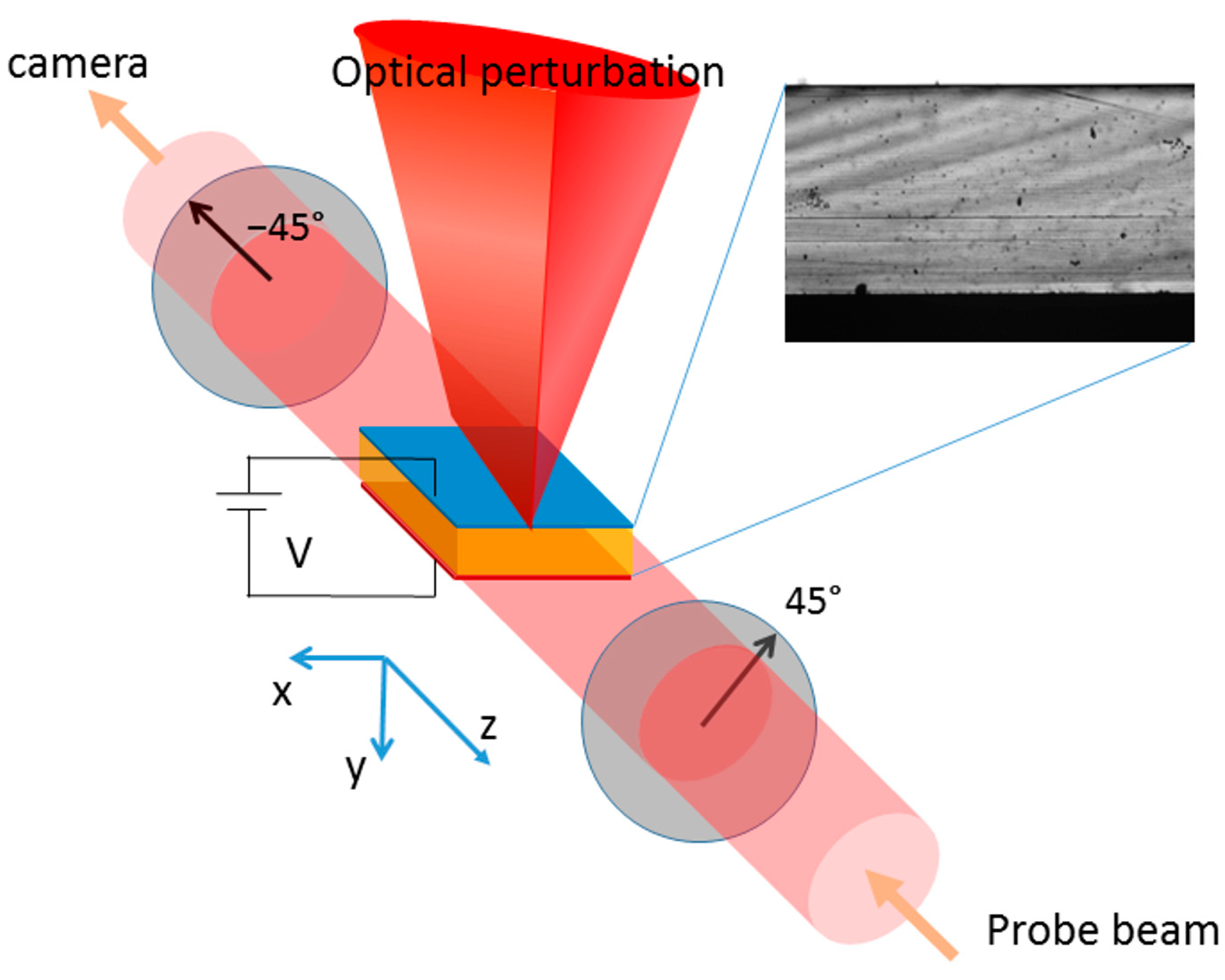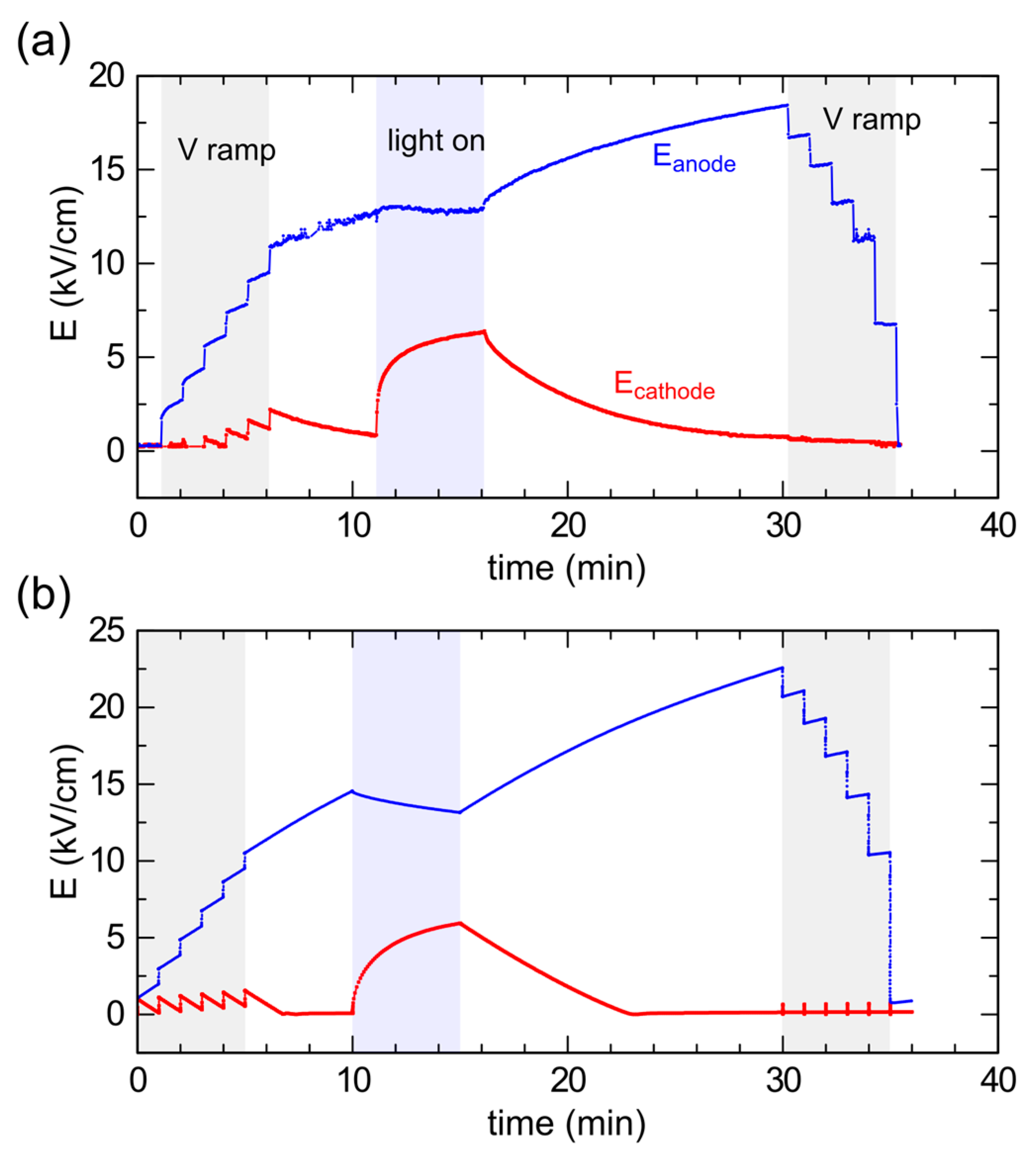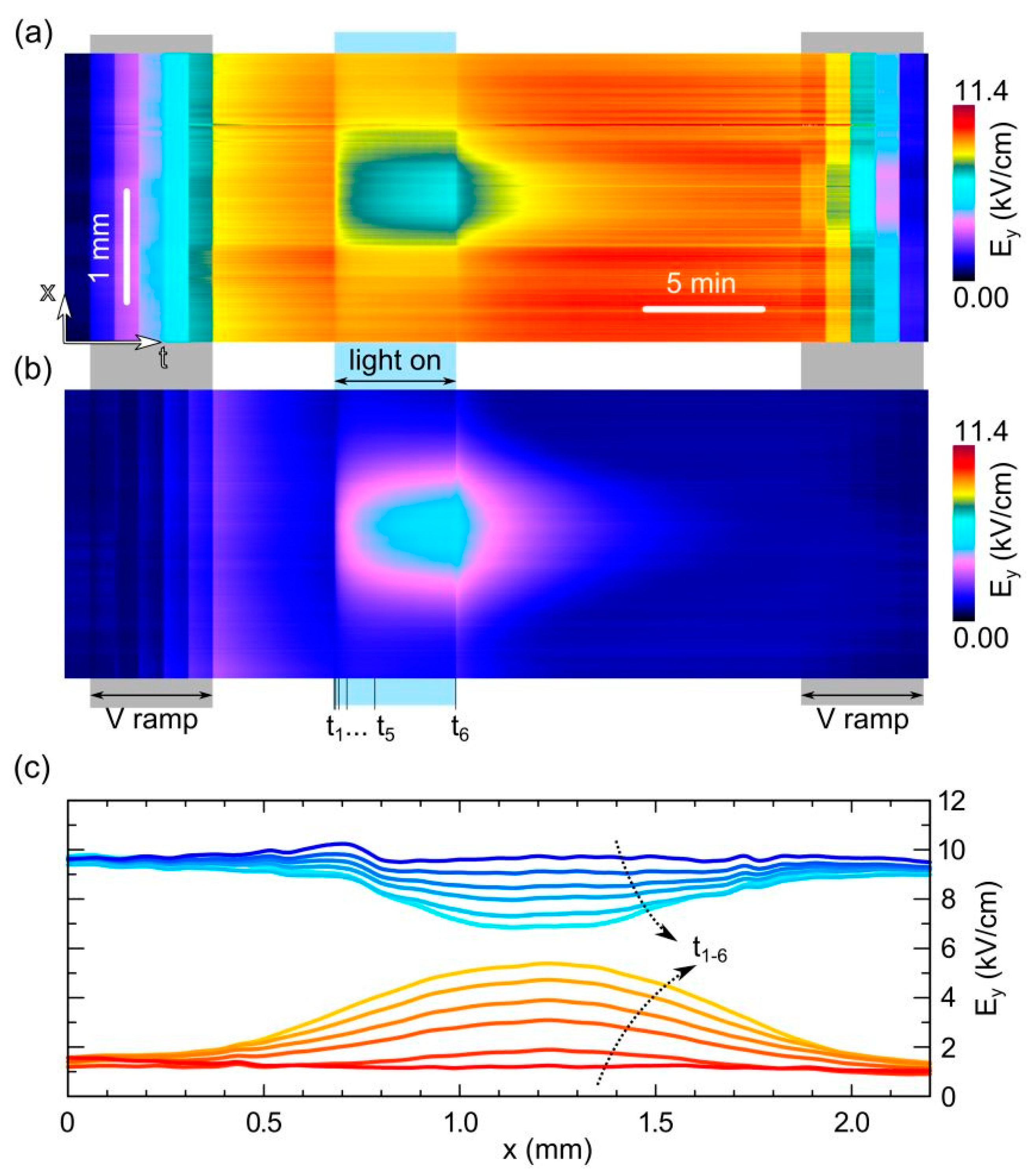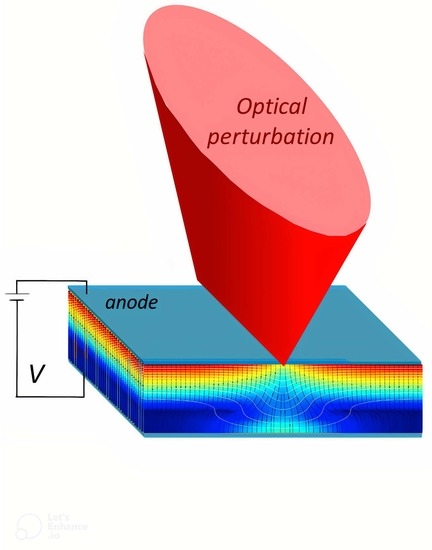Electric-Field Mapping of Optically Perturbed CdTe Radiation Detectors
Abstract
1. Introduction
2. Experimental Methods and Numerical Simulations
3. Results
3.1. Electro-Optic Images and Electric-Field Maps
3.2. Space-Charge Retrieval
3.3. Numerical Profiles at Increasing Power
3.4. Time Dynamics
3.5. Full Time–Space Charts
4. Discussion
Supplementary Materials
Author Contributions
Funding
Institutional Review Board Statement
Informed Consent Statement
Data Availability Statement
Acknowledgments
Conflicts of Interest
References
- Bale, D.S.; Szeles, C. Electron transport and charge induction in cadmium zinc telluride detectors with space charge build up under intense x-ray irradiation. J. Appl. Phys. 2010, 107, 114512. [Google Scholar] [CrossRef]
- Turturici, A.A.; Abbene, L.; Franc, J.; Grill, R.; Dědič, V.; Principato, F. Time-dependent electric field in Al/CdTe/Pt detectors. Nucl. Instrum. Methods Phys. Res. Sect. A 2015, 795, 58–64. [Google Scholar] [CrossRef]
- Cola, A.; Farella, I. The polarization mechanism in CdTe Schottky detectors. Appl. Phys. Lett. 2009, 94, 102113. [Google Scholar] [CrossRef]
- Franc, J.; Dědič, V.; Zázvorka, J.; Hakl, M.; Grill, R.; Sellin, P.J. Flux-dependent electric field changes in semi-insulating CdZnTe. J. Phys. D Appl. Phys. 2013, 46, 235306. [Google Scholar] [CrossRef]
- Cola, A.; Farella, I. Electric Field and Current Transport Mechanisms in Schottky CdTe X-Ray Detectors under Perturbing Optical Radiation. Sensors 2013, 13, 9414–9434. [Google Scholar] [CrossRef]
- Cola, A.; Farella, I. CdTe X-Ray Detectors under Strong Optical Irradiation. Appl. Phys. Lett. 2014, 105, 203501. [Google Scholar] [CrossRef]
- Franc, J.; Dědič, V.; Rejhon, M.; Zázvorka, J.; Praus, P.; Touš, J.; Sellin, P.J. Control of electric field in CdZnTe radiation detectors by above-bandgap light. J. Appl. Phys. 2015, 117, 165702. [Google Scholar] [CrossRef]
- Dědič, V.; Franc, J.; Rejhon, M.; Zázvorka, J.; Sellin, P. De-polarization of a CdZnTe radiation detector by pulsed infrared light. Appl. Phys. Lett. 2015, 107, 032105. [Google Scholar] [CrossRef]
- Pekárek, J.; Dědič, V.; Franc, J.; Belas, E.; Rejhon, M.; Moravec, P.; Touš, J.; Voltr, J. Infrared LED Enhanced Spectroscopic CdZnTe DetectorWorking under High Fluxes of X-rays. Sensors 2016, 16, 1591. [Google Scholar] [CrossRef] [PubMed]
- Turturici, A.A.; Franc, J.; Grill, R.; Dědič, V.; Abbene, L.; Principato, F. Electric field manipulation in Al/CdTe/Pt detectors under optical perturbations. Nucl. Instrum. Methods Phys. Res. Sect. A 2017, 858, 36–43. [Google Scholar] [CrossRef]
- Cola, A.; Dominici, L.; Valletta, A. Optical Writing and Electro-Optic Imaging of Reversible Space Charges in Semi-Insulating CdTe Diodes. Sensors 2022, 22, 1579. [Google Scholar] [CrossRef] [PubMed]
- Prokesch, M.; Bale, D.S.; Szeles, C. Fast High-Flux Response of CdZnTe X-Ray Detectors by Optical Manipulation of Deep Level Defect Occupations. IEEE Trans. Nucl. Sci. 2010, 57, 2397–2399. [Google Scholar] [CrossRef]
- Dorogov, P.; Ivanov, V.; Loutchanski, A.; Grigorjeva, L.; Millers, D. Improving the performance of CdZnTe detectors using infrared stimulation. In Proceedings of the IEEE Nuclear Science Symposium Conference Record, Valencia, Spain, 23–29 October 2011; pp. 4557–4561. [Google Scholar] [CrossRef]
- Luo, X.; Zha, G.; Xu, L.; Jie, W. Improvement to the Carrier Transport Properties of CdZnTe Detector Using Sub-Band-Gap Light Radiation. Sensors 2019, 19, 600. [Google Scholar] [CrossRef]
- Sato, G.; Fukuyama, T.; Watanabe, S.; Ikeda, H.; Ohta, M.; Ishikawa, S.N.; Takahashi, T.; Shiraki, H.; Ohno, R. Study of polarization phenomena in Schottky CdTe diodes using infrared light illumination. Nucl. Instrum. Methods Phys. Res. Sect. A 2011, 652, 149–152. [Google Scholar] [CrossRef]
- Cola, A.; Farella, I.; Auricchio, N.; Caroli, E. Investigation of the electric field distribution in x-ray detectors by Pockels effect. J. Opt. A Pure Appl. Opt. 2006, 8, S467. [Google Scholar] [CrossRef]
- Bolotnikov, A.E.; Cook, W.R.; Harrison, F.A.; Wong, A.-S.; Schindler, S.M.; Eichelberger, A.C. Charge loss between contacts of CdZnTe pixel detectors. Nucl. Instrum. Methods Phys. Res. Sect. A 1999, 432, 326–331. [Google Scholar] [CrossRef]
- Buttacavoli, A.; Principato, F.; Gerardi, G.; Cascio, D.; Raso, G.; Bettelli, M.; Zappettini, A.; Seller, P.; Veale, M.C.; Abbene, L. Incomplete Charge Collection at Inter-Pixel Gap in Low- and High-Flux Cadmium Zinc Telluride Pixel Detectors. Sensors 2022, 22, 1441. [Google Scholar] [CrossRef]
- Bale, D.S.; Soldner, S.A.; Szeles, C. A mechanism for dynamic lateral polarization in CdZnTe under high flux x-ray irradiation. Appl. Phys. Lett. 2008, 92, 082101. [Google Scholar] [CrossRef]
- Nie, L.; Xiao, S.; Li, M.; Wang, X.; Zhang, J.; Kong, W. Accumulated-carrier screening effect based investigation for the pixellated CdZnTe radiation detector. In Proceedings of the 2013 IEEE 12th International Conference on Cognitive Informatics and Cognitive Computing, New York, NY, USA, 16–18 July 2013; pp. 473–476. [Google Scholar] [CrossRef]
- Wang, X.; Xiao, S.; Li, M.; Zhang, L.; Cao, Y.; Chen, Y. Further process of polarization within a pixelated CdZnTe detector under intense x-ray irradiation. Nucl. Instrum. Methods Phys. Res. Sect. A 2013, 700, 75–80. [Google Scholar] [CrossRef]
- Sato, T.; Sato, K.; Ishida, S.; Kin, M.; Hirooka, M.; Yamada, M.; Kanamori, H. Local Polarization Phenomena in In-Doped CdTe X-Ray Detector Arrays. IEEE Trans. Nucl. Sci. 1995, 42, 1513–1518. [Google Scholar] [CrossRef]
- Soldner, S.A.; Narvett, A.J.; Covalt, D.E.; Szeles, C. Characterization of the Charge Transport Uniformity of CdZnTe Crystals for Large-Volume Nuclear Detector Applications. IEEE Trans. Nucl. Sci. 2004, 51, 2443–2447. [Google Scholar] [CrossRef]
- Veale, M.C.; Booker, P.; Cross, S.; Hart, M.D.; Jowitt, L.; Lipp, J.; Schneider, A.; Seller, P.; Wheater, R.M.; Wilson, M.D.; et al. Characterization of the Uniformity of High-Flux CdZnTe Material. Sensors 2020, 20, 2747. [Google Scholar] [CrossRef]
- Camarda, G.S.; Bolotnikov, A.E.; Cui, Y.; Hossain, A.; Awadalla, S.A.; Mackenzie, J.; Chen, H.; James, R.B. Polarization Studies of CdZnTe Detectors Using Synchrotron X-Ray Radiation. IEEE Trans. Nucl. Sci. 2008, 55, 3725–3730. [Google Scholar] [CrossRef]
- Bolotnikov, A.E.; Camarda, G.S.; Cui, Y.; Hossain, A.; Yang, G.; Yao, H.W.; James, R.B. Internal Electric-Field-Lines Distribution in CdZnTe Detectors Measured Using X-Ray Mapping. IEEE Trans. Nucl. Sci. 2009, 56, 791–794. [Google Scholar] [CrossRef]
- Dědič, V.; Fridrišek, T.; Franc, J.; Kunc, J.; Rejhon, M.; Roy, U.N.; James, R.B. Mapping of inhomogeneous quasi-3D electrostatic field in electro-optic materials. Sci. Rep. 2021, 11, 1–10. [Google Scholar] [CrossRef] [PubMed]
- Sentaurus “SentaurusTM Device User Guide. Version N-2017.09.” Synopsys Inc., Sep. 2017. Available online: https://www.synopsys.com/silicon/tcad/device-simulation/sentaurus-device.html (accessed on 13 April 2023).
- Cola, A.; Farella, I.; Anni, M.; Martucci, M.C. Charge transients by variable wavelength optical pulses in CdTe nuclear detectors. IEEE Trans. Nucl. Sci. 2012, 59, 1569–1574. [Google Scholar] [CrossRef]
- Farella, I.; Montagna, G.; Mancini, A.M.; Cola, A. Study on Instability Phenomena in CdTe Diode-Like Detectors. IEEE Trans. Nucl. Sci. 2009, 56, 1736–1742. [Google Scholar] [CrossRef]
- Cola, A.; Farella, I.; Pousset, J.; Valletta, A. On the relation between deep level compensation, resistivity and electric field in semi-insulating CdTe: Cl radiation detectors. Semicond. Sci. Technol. 2016, 31, 12LT01. [Google Scholar] [CrossRef]
- Franc, J.; James, R.B.; Grill, R.; Dědič, V.; Belas, E.; Praus, P.; Prekas, G.; Sellin, P.J. Influence of Contacts on Electric Field in an Au/(CdZn)Te/Au Detector: A Simulation. IEEE Trans. Nucl. Sci. 2010, 57, 2349–2358. [Google Scholar] [CrossRef]
- Bale, D.S.; Szeles, C. Nature of polarization in wide-bandgap semiconductor detectors under high-flux irradiation: Application to semi-insulating Cd1−xZnxTe. Phys. Rev. B 1998, 77, 035205. [Google Scholar] [CrossRef]






Disclaimer/Publisher’s Note: The statements, opinions and data contained in all publications are solely those of the individual author(s) and contributor(s) and not of MDPI and/or the editor(s). MDPI and/or the editor(s) disclaim responsibility for any injury to people or property resulting from any ideas, methods, instructions or products referred to in the content. |
© 2023 by the authors. Licensee MDPI, Basel, Switzerland. This article is an open access article distributed under the terms and conditions of the Creative Commons Attribution (CC BY) license (https://creativecommons.org/licenses/by/4.0/).
Share and Cite
Cola, A.; Dominici, L.; Valletta, A. Electric-Field Mapping of Optically Perturbed CdTe Radiation Detectors. Sensors 2023, 23, 4795. https://doi.org/10.3390/s23104795
Cola A, Dominici L, Valletta A. Electric-Field Mapping of Optically Perturbed CdTe Radiation Detectors. Sensors. 2023; 23(10):4795. https://doi.org/10.3390/s23104795
Chicago/Turabian StyleCola, Adriano, Lorenzo Dominici, and Antonio Valletta. 2023. "Electric-Field Mapping of Optically Perturbed CdTe Radiation Detectors" Sensors 23, no. 10: 4795. https://doi.org/10.3390/s23104795
APA StyleCola, A., Dominici, L., & Valletta, A. (2023). Electric-Field Mapping of Optically Perturbed CdTe Radiation Detectors. Sensors, 23(10), 4795. https://doi.org/10.3390/s23104795







